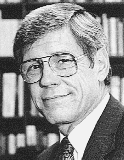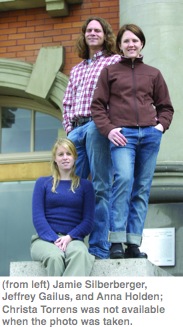Around the Oval
Brennan’s Wave
 A kayaker maneuvers a rapid on Brennan’s Wave, a whitewater park on the Clark Fork River in downtown Missoula. The park was created after years of fundraising by the Missoula Whitewater Association. An old dam and debris were cleared away and rocks and boulders were placed strategically to make a challenging kayak run. Located just below the viewing deck at Caras Park, the park offers rapids for kayakers, tubers, and rafters, as well as fun for viewers on Higgins Street Bridge or at Caras Park. The park is named for Brennan Guth, a UM alum, native Missoulian, and accomplished kayaker who died in a boat accident in 2001. It was his dream to put a whitewater area in the heart of Missoula. The wave is also being used as an educational facility by local search and rescue teams, individuals, and groups.
A kayaker maneuvers a rapid on Brennan’s Wave, a whitewater park on the Clark Fork River in downtown Missoula. The park was created after years of fundraising by the Missoula Whitewater Association. An old dam and debris were cleared away and rocks and boulders were placed strategically to make a challenging kayak run. Located just below the viewing deck at Caras Park, the park offers rapids for kayakers, tubers, and rafters, as well as fun for viewers on Higgins Street Bridge or at Caras Park. The park is named for Brennan Guth, a UM alum, native Missoulian, and accomplished kayaker who died in a boat accident in 2001. It was his dream to put a whitewater area in the heart of Missoula. The wave is also being used as an educational facility by local search and rescue teams, individuals, and groups.
Um Researchers' Papers published in Science

From tracking viruses between species to detecting a leak on the sixth moon of Saturn, UM research scientists are gaining the attention of the national science community. Mary Poss, an associate professor of biological sciences, and Dan Reisenfeld, assistant professor of physics and astronomy, recently had papers published in Science, one of the world’s leading research journals.
“Science publishes research that is innovative and that advances or challenges a field. It is always nice to have some confirmation that your research falls into one of those categories,” says Poss, who studies the transfer of viruses from one species to another.
Reisenfeld is one of several scientists analyzing data from NASA’s Cassini spacecraft. His find is a plume of gas that vents from the south pole of Enceladus, the icy sixth moon of Saturn. The plume evidently explains the mysteriously high levels of water vapor found in Saturn’s magnetosphere. Last summer, a closer look at the moon, one of nearly fifty known moons of Saturn, revealed it has a slight atmosphere, making it only the third moon in the solar system to have one. And it has volcanic activity. Previously scientists had theorized that the ionized water around Saturn came from its rings, but Reisenfeld’s latest finding now means Enceladus is the source. “I love being part of this,” Reisenfeld says. “This is pure discovery. You are learning something that nobody on the entire planet ever knew.”
Reisenfeld is part of a team headed by Bob Tokar of Los Alamos National Laboratory.
Closer to home, Poss’s research centers on the transfer of viruses with the idea this information can be used to track the distribution of animal populations. Her work began nearly ten years ago when she was doing research at the University of Washington. While there, she demonstrated that a person infected with HIV had genetically distinct populations of the HIV-1 virus in their bodily tissues.
“It occurred to me that if we could identify genetically distinct populations of the virus in different tissues from a single individual, that we should be able to use the virus to determine how infected animals were distributed on a landscape,” Poss says.
Poss and her colleagues studied the feline immunodeficiency virus in cougar populations in Montana, Wyoming, British Columbia, and Alberta. Even though household cats who carry the disease have severe health problems, a cougar can carry the virus with few health problems.
Poss studied the virus in the cougars because it allowed her and her colleagues to easily track the animal’s genetic mutations. Mutations can provide researchers with information that helps them follow recent demographic changes in an animal population. These changes can’t be tracked using genetic information from the animals studied because the genes don’t undergo rapid change, but a virus can, Poss says. She collaborated in the research and the writing of the paper with Roman Biek, a postdoctoral fellow at Emory University, and Alexai Drummond, a computer science faculty member at the University of Auckland in New Zealand.
The President's Corner
 As this issue of the Montanan goes to press, two new initiatives will soon claim public attention, nationally as well as within the state. For some time, I have sought to raise awareness of the erosion of the so-called “social contract” in this country. That term refers to the traditional obligation of the current generation of Americans to educate the next generation. The strength of the historic commitment passed on from generation to generation in large measure explains the astonishing social, economic, and cultural accomplishments of this country.
As this issue of the Montanan goes to press, two new initiatives will soon claim public attention, nationally as well as within the state. For some time, I have sought to raise awareness of the erosion of the so-called “social contract” in this country. That term refers to the traditional obligation of the current generation of Americans to educate the next generation. The strength of the historic commitment passed on from generation to generation in large measure explains the astonishing social, economic, and cultural accomplishments of this country.
However, since the late 1970s, its acceptance has gradually waned as more and more people have come to view higher education as a private rather than a public good. That view reflects the correct but relatively narrow conclusion that since graduates enjoy higher incomes throughout their lives, they incur the obligation to pay for that private benefit. Along with virtually everyone who analyzes the benefits of higher education, I think the focus on the economic benefits to individuals fails to take into account the larger public value of investment in higher education.
Consider just a couple of additional benefits: college graduates pay 100 percent more in federal taxes and 82 percent more in state taxes than high school graduates over their lifetimes; and a single percentage point increase in the proportion of four-year degree holders in a city increases the average wages of workers without high school diplomas by at least 1.9 percent and of high school graduates by 1.6 percent. These economic benchmarks do not mention the very significant cultural, political, health, and quality of life benefits that accrue to the society at large.
The two initiatives designed to alert people to the dangers of the largely unplanned trend toward “privatization” of public higher education include one at the national level and one within the state. The American Council on Education has launched a campaign titled “Solutions for Our Future” that seeks to inform people about the perils of disinvesting in higher education. This effort began during the NCAA national basketball tournament, with free airtime provided by the national networks and the NCAA; it will run for three years. UM has participated in the effort from the outset and will lead the challenge to bring the campaign to Montana.
The state initiative involves a pilot program that UM has launched, with approval of the Board of Regents, to make certain that cost does not interfere with access to public higher education in Montana. MPACT—Montana Partnering for Affordable College Tuition—relies on federal grants, work-study funds, and institutional grants to persuade qualified Montana high school graduates from median-income families that college is possible for them. We have alerted all state high school principals and counselors and will continue the effort to make certain that high school graduates take advantage of the program. I personally believe that MPACT will increase college participation and that it will merit extension to all campuses of the Montana University System.
The time has come to reverse a trend that will surely weaken this country’s social fabric, economic competitiveness, and cultural vitality.
![]()
George M. Dennison ’62, ’63
President and Professor of History
Students Named fellows


A $5,000 stipend for a summer internship and up to $25,000 for next year’s tuition is a dream come true for any student. For four UM students, those benefits are only part of a great opportunity they were given when named Doris Duke Conservation Fellows by the Woodrow Wilson National Fellowship Foundation.
The fellowships were awarded to Jeffrey Gailus, Anna Holden, Jamie Silberberger, and Christa Torrens, all graduate students in the University’s Environmental Studies Program. They are among twenty-four fellows named nationwide.
In addition to the monetary assistance and an internship of their choice, the fellowships provide the students with opportunities to meet and learn from other Duke fellows at an annual conference this fall. “The network of other fellows—all interested in conservation issues—from across the U.S.—is priceless,” Torrens says. Holden agrees. “It means that I will have access to resources that I wouldn’t have had access to,” she says. “This widens my suitcase of experience.”
The Woodrow Wilson National Fellowship Foundation manages the fellowship program with participating universities. UM students are in good company: other participating universities include Yale, Duke, and the universities of Michigan and Wisconsin.
Holden says UM was selected with those universities because it fits the criteria that the selection committee has set. “The Doris Duke Foundation is looking for future conservation leaders,” she says. “Obviously, the Environmental Studies Program at UM is fostering this type of leader. Self motivation is a huge factor in our program, which makes finding leaders here easy.”
Holden says the fact that four UM students won fellowships says a lot for the Environmental Studies Program. The students were selected by environmental studies faculty based on their academic performance resume and two essays.
Silberberger says, given the competition for the fellowships, she is honored to be selected. “I feel especially grateful to represent the environmental studies department at The University of Montana; that the fellowship was bestowed on me by the department’s exceptional faculty is really, I feel, an honor in itself. The alleviation of the tuition burden is not bad, either!” —Crystal Stipe
A Guggenheim for Blunt
 Move over, Dick Hugo. Judy Blunt, UM associate professor of English and author of the 2002 memoir Breaking Clean, won a coveted Guggenheim Fellowship Award this year, the first faculty member in the University’s Creative Writing Program to receive a Guggenheim since Hugo in 1970.
Move over, Dick Hugo. Judy Blunt, UM associate professor of English and author of the 2002 memoir Breaking Clean, won a coveted Guggenheim Fellowship Award this year, the first faculty member in the University’s Creative Writing Program to receive a Guggenheim since Hugo in 1970.
Guggenheim Fellows are appointed on the basis of distinguished achievement in the past and promise for future accomplishment. The award, which averaged $38,000 last year, will allow Blunt to take a sabbatical during spring 2007. She will spend the time working on a book of essays about strength and storytelling among women in the West.
Blunt ’91, M.A. ’94, is among 187 winners of 2006 Guggenheim Fellowships selected from nearly 3,000 applicants in 78 different fields. The John Simon Guggenheim Memorial Foundation will award $7.5 million in this year’s competition, its 82nd.
Breaking Clean described Blunt’s struggle for independence during more than thirty years on isolated wheat and cattle ranches in northeastern Montana. The book won the PEN/Jerard Fund Award and the Whiting Writers’ Award.
|
|
|
|
 Helen Derheim rehearses a piece titled “Is Today the Day?” choreographed by Callie Yeager. Both are UM students. The dance was performed in UM Drama/Dance Department’s Spring Dance Showcase. |
||
|
|
|
More for your Money
 UM is one of the nation’s best values in higher education, according to The Princeton Review. In its 2007 edition of America’s Best Value Colleges, the review included the University in the country’s top 150 undergraduate colleges in value, citing key factors of excellence in academics, generous financial-aid packages, and relatively low costs.
UM is one of the nation’s best values in higher education, according to The Princeton Review. In its 2007 edition of America’s Best Value Colleges, the review included the University in the country’s top 150 undergraduate colleges in value, citing key factors of excellence in academics, generous financial-aid packages, and relatively low costs.
This marks the first time UM has been included as a best-value college. The University has been profiled in The Princeton Review’s Best 361 Colleges for several years and is the only Montana college profiled in the new book. The Princeton Review chose colleges based on institutional data and student opinion surveys collected from 646 colleges and universities from fall 2004 through summer 2005.
“The University of Montana has all the ingredients of a happy college experience: friendly people, supportive faculty, a great sense of community and fantastic educational opportunities—all served up with a side of lovely scenery,” says the opening paragraph of the three-page UM profile. “The academics are solid, the location is astonishing, and the price is right,” reads a quote highlighting UM’s profile.
The book’s publishers considered more than thirty factors to rate colleges in four categories: academics, tuition GPA (the sticker price minus the average amount students receive in scholarships and grants), financial aid (how well colleges meet students’ financial need), and student borrowing.
The book’s authors credit UM for creative development of innovative programs, including scholarships. One such program, MPACT—Montana Partnering for Affordable College Tuition—is being rolled out this spring for fall semester. MPACT makes it possible, through significant financial assistance, for moderate- to low-income students who graduate from Montana high schools to attend UM.